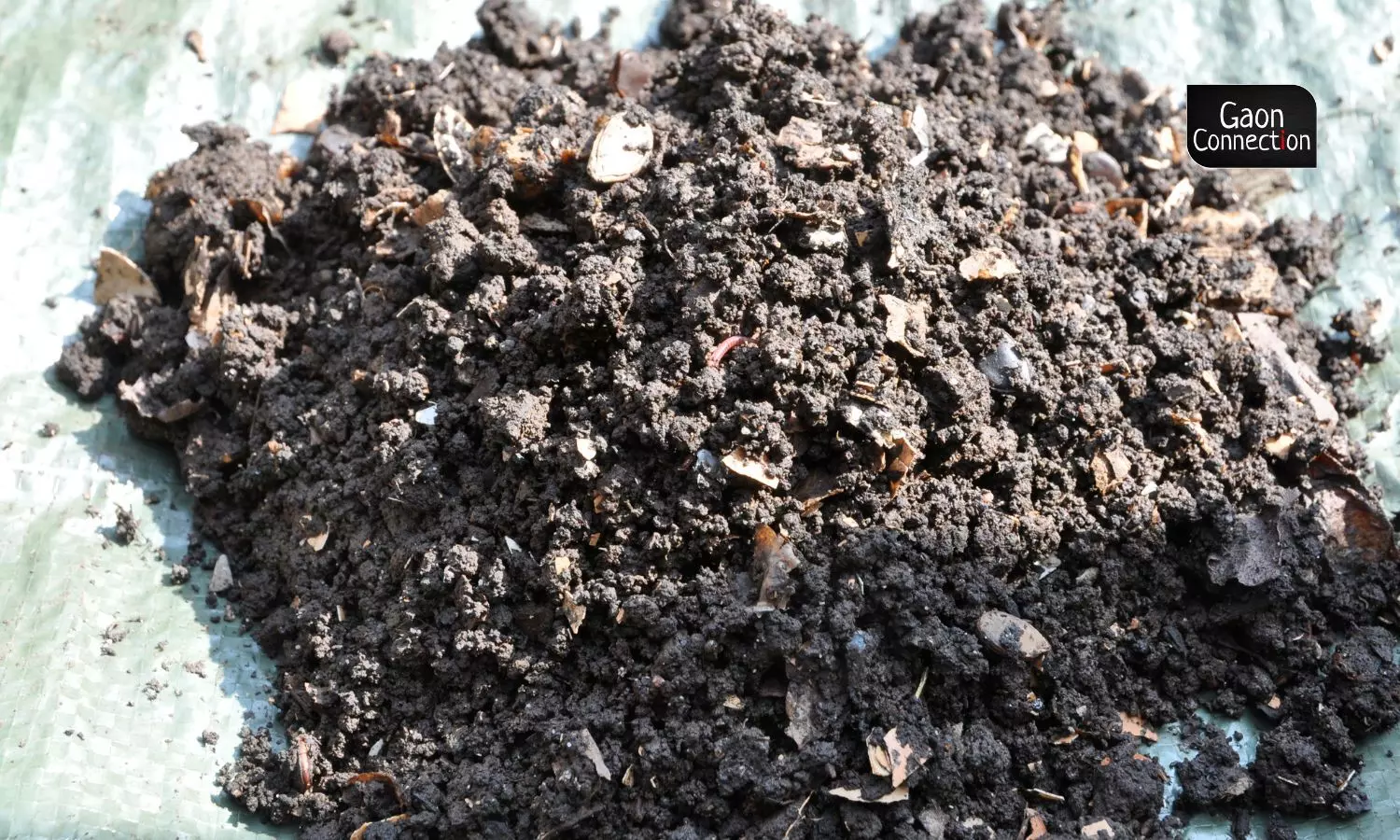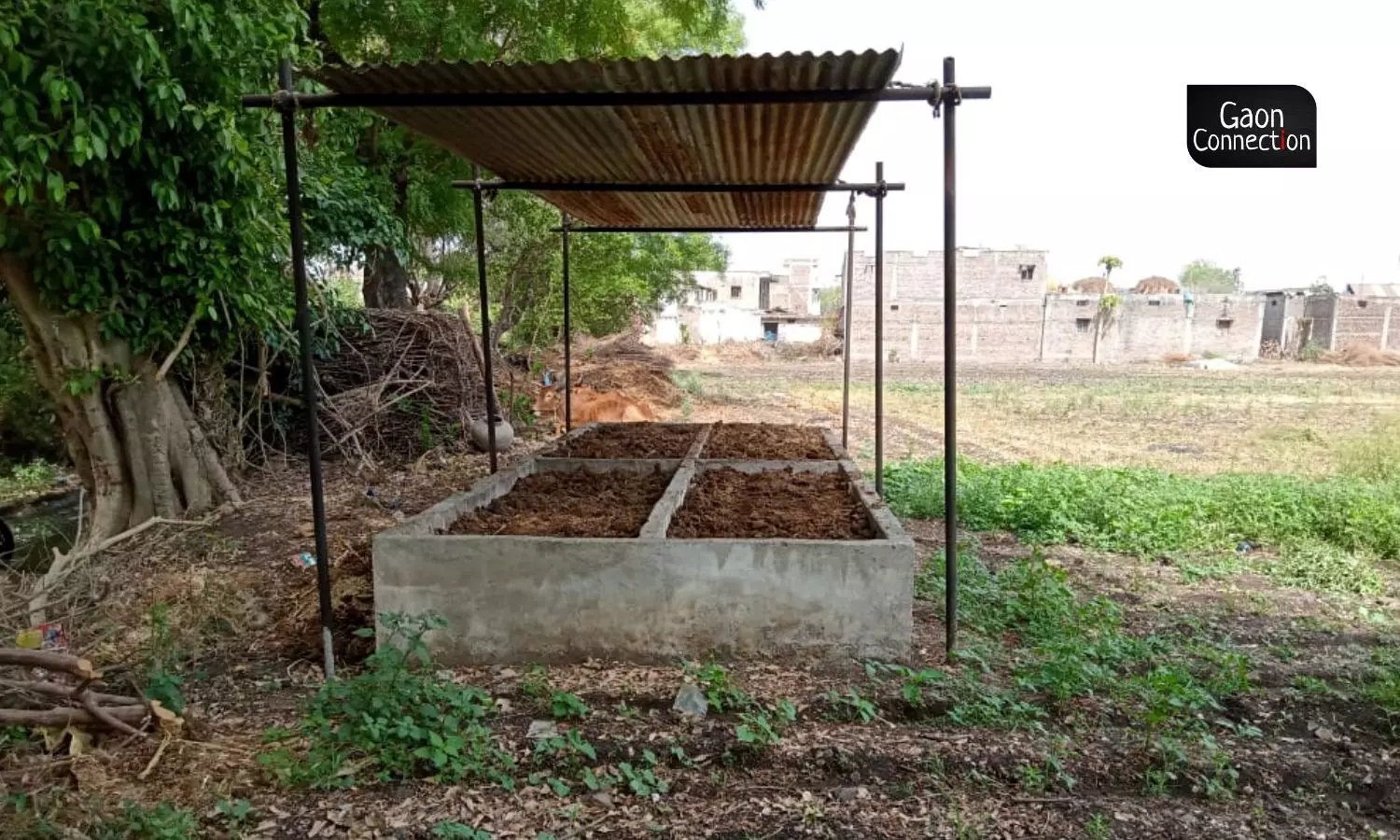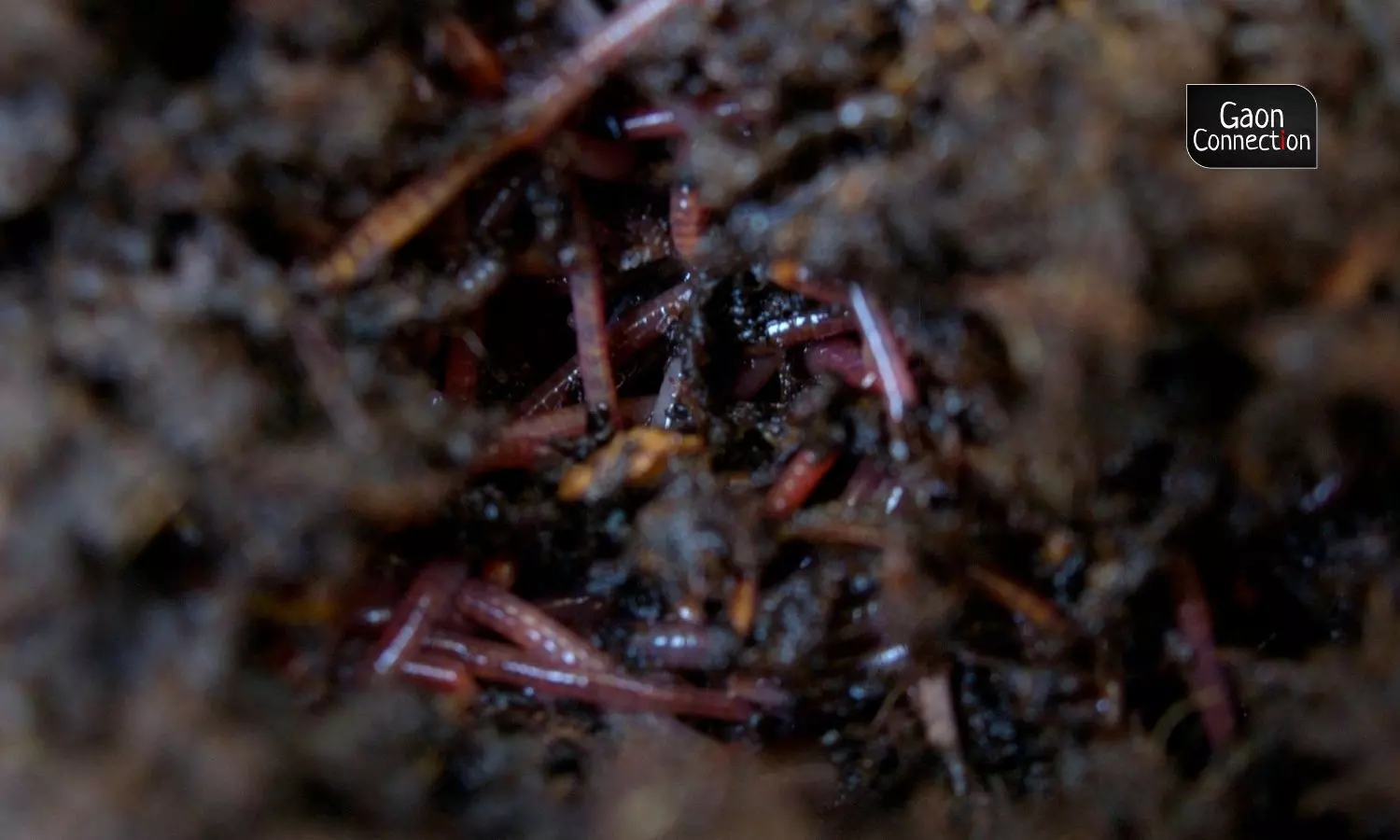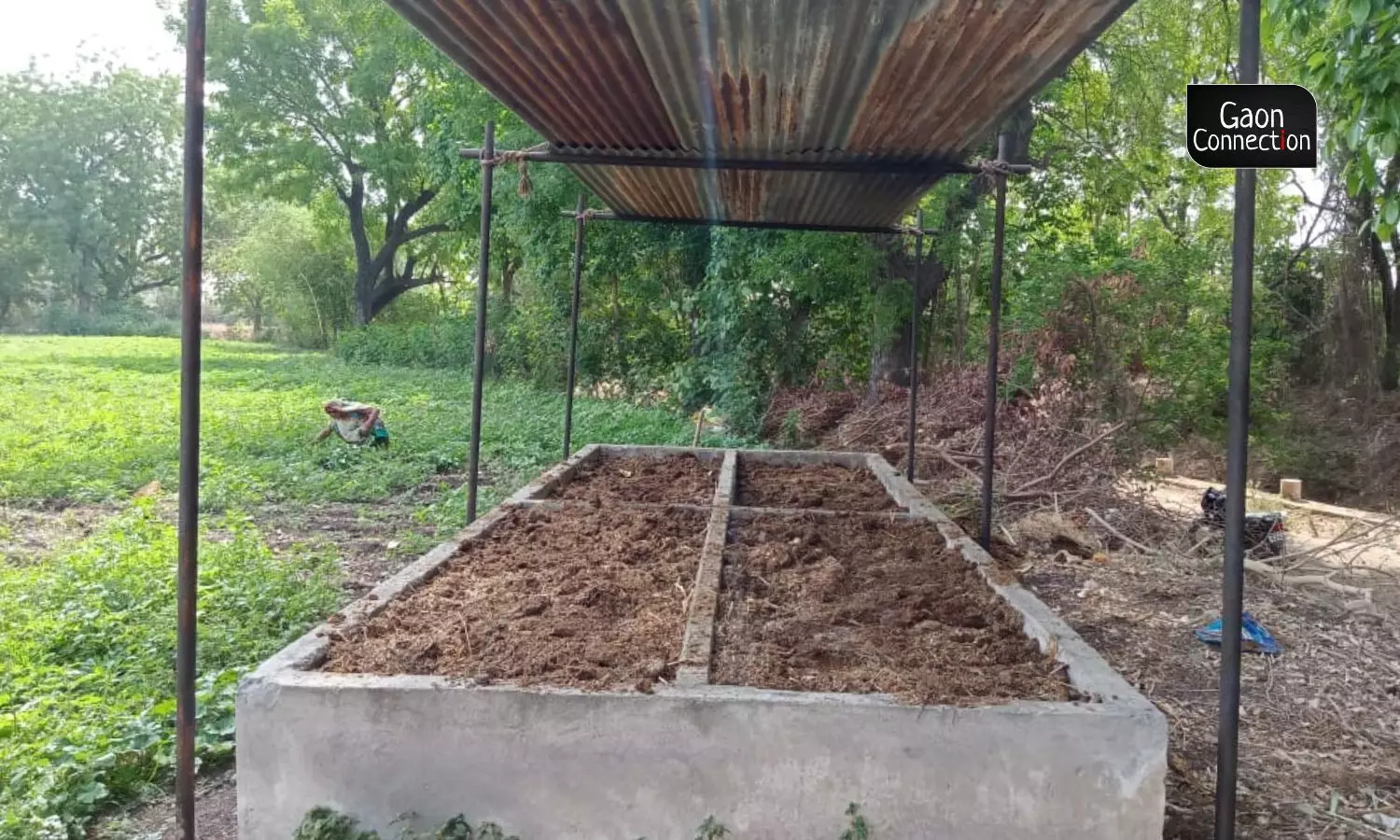Even in the peak winter season, when it is still dark outside, Sona Patel’s day starts at 5 AM. As soon as she wakes up, she heads to the cattle shed where two cows, two buffaloes and four goats await her. She unties them, and then ties them back at the khuta (spot designated for collection of cattle dung). Only after this daily ritual, does her other morning chores start. Apart from providing milk, her cattle is a sought-after source of dung, which Patel uses to make vermicompost.
Patel is a resident of Bapdud village in Madhya Pradesh’s Dhar district — situated at a distance of about 300 kilometres from state capital Bhopal.
“12 baj jaate hain poora kaam nibtaane me,” she told Gaon Connection [I get done only by noon]. “It takes me 15 minutes to carry the cattle dung in a basket to the pit where we dump our organic waste which is used to make khaad [vermicompost]. It takes another 15 minutes to return to the shed. I make eight such trips to and fro to dump four baskets of dung,” Patel, whose husband owns 12 bighas [almost three hectares of land] added.
Vermicompost is a naturally produced fertiliser (using earthworms) which has reduced Patel household’s dependence on chemical fertilisers. Latter is not only expensive but is often in short supply during the peak farming season.
In 2019, Sona Patel and her husband Ranchhod, along with 73 other farmers from eight villages in the Manawar block had attended a training organised by Transform Rural India Foundation (TRIF) — a grassroots foundation that works with marginalised communities in rural India.
The training involved sessions on building a vermicompost unit that can help them financially as well as maintain the soil health in their agricultural fields. The farmers were trained in making manure and acquiring earthworms (to make vermicompost) from the market.

ermicompost, apart from supplying nutrients and growth enhancing hormones to plants, improves the soil structure leading to increase in water and nutrient holding capacities of soil. (Photo sourced via Flickr)
As of now, a total of 75 farmers in the Manawar block of Dhar district in Madhya Pradesh are engaged in making vermicompost which is used to add fertility in their agricultural fields. This has reduced their financial burden of buying chemical fertilisers and also improved soil health.
Also Read: Uttar Pradesh: BomLife bio-fertiliser helping increase crop production in Basti
“All the effort that goes into making vermicompost is worth it as it saves me more than Rs 12,000 in a year which were earlier spent on chemical fertilisers like DAP [Diammonium phosphate] and urea,” said Patel.
According to Sanjay Bhuriya, TRIF’s farm prosperity executive for the Manawar block, the welfare programme of training farmers to make vermicompost was incepted after realising the pressing need to utilise the rural farm waste in an efficient manner.
“When we were developing the Gram Panchayat Development Plan(GPDP), we noticed that we needed to utilise the cow dung and other organic waste which used to be dumped roadside or on a corner in the fields. We wondered how to associate them with a government scheme. The farmers had never heard about vermicompost before and it required some capacity building programmes to train them for it,” Bhuriya explained.
The welfare programme is jointly run by TRIF, the Agricultural Technology Management Agency (ATMA), and the state government’s Department of Horticulture and Food Processing.
TRIF has tied up with the National Rural Livelihood Mission [NRLM] to utilise their social assets like self help groups (SHGs) to include women on the project and further build their capacity.
“Ninety per cent of agricultural labour is handled by women. From collecting gobar [dung], to transporting it to units, watering it, and spreading it in the fields, women play an extremely crucial role,” Bhuriya said.

The process of making manure involves dumping the cow dung and other collected organic waste in the vermicompost unit introducing two kilogrammes of earthworms after 15 days which act as a catalyst in the decomposition process. It is vital to provide water for moisture in this deposited waste through the course of 65-90 days.(Photo sourced via TRIF)
Sohan Chauhan, who owns 10-bighas [almost an hectare] in Brahmanpuri village has built five vermicompost beds in his fields and 15 quintals of vermicompost is produced every three months through his vermicompost methodology — which saves 10 quintals for his own land, and selling the remaining at Rs 6 per kg.
“One vermicompost bed was built by ATMA people, the other four I built from my own pocket. It cost me Rs 5,000 per bed,” Chauhan said.
His 45-year-old wife Kusum Chauhan could speak only the local dialect Nimadi but Sohan acknowledged that an exceeding share of physical labour that goes into making the vermicompost is contributed by his wife.
Also read: Rural employment generation through biogas production in villages of India
Post-training execution
The execution of the project began by TRIF in 2019 by building four concrete vermicompost units of dimensions 10ft x 3ft x 2.5ft [length, breath, depth] in the villages of Bapdud, Doncha, Balipur and Bidpura along with the allocation of the earthworms to 50 farmers. The daily management was taken care of by the farmers themselves and as per the TRIF official, the vermicompost was used in a crop-targeting manner rather than being spread out through the entire field.
“The farmers use the vermicompost for their own fields and then sell the additional manure which also provides financial aid. In Brahmanpuri, ten units were developed under the ATMA scheme with the district government’s help after our initial push,” Bhuriya informed.
Also Read: Banswara’s migrant tribal labourers are now proud organic farmers
The process of making manure involves dumping the cow dung and other collected organic waste in the vermicompost unit introducing two kilogrammes of earthworms after 15 days which act as a catalyst in the decomposition process. It is vital to provide water for moisture in this deposited waste through the course of 65-90 days.
As per the notes on compost practices which are cited by the Union Ministry of Agriculture and Farmers, the earthworms being voracious eaters consume the biodegradable matter and give out a part of the matter as excreta or vermi-castings.
“The vermi-casting containing nutrients is a rich manure for the plants. Vermicompost, apart from supplying nutrients and growth enhancing hormones to plants, improves the soil structure leading to increase in water and nutrient holding capacities of soil. Fruits, flowers and vegetables and other plant products grown using vermicompost are reported to have better keeping quality,” the agriculture ministry’s notes on vermicomposting mention.
Water woes a pertinent issue
When Gaon Connection talked to the beneficiaries of the programme, it was learnt that a major challenge which bothers them is the requirement of water in the vermicompost pit.
The moisture content which needs to be maintained continuously during the process needs almost 15-20 litres of water once in two-three days over a course of 65-90 days. The situation is better during monsoons when rainfall helps ease the demand.
“Though we have a well in our field, not too far from our khaad [manure] unit, the pipe doesn’t reach till there. We use dabbas [plastic containers] to carry water from the well to sprinkle it in the unit every three days. It is mostly done by Sona, my wife but I too help whenever she has other tasks to complete,” said Ranchhod Patel, Sona’s husband.
Sona spends 10 minutes in one trip fetching water, and daily takes almost eight trips from well to the unit.
Bhuriya, the TRIF official, too acknowledged that though many houses have a tap connection under the Union government’s Har-Ghar-Nal Yojna, inconveniences in fetching water for the vermicompost persists, which needs to be addressed.
“Most of the villages have enough groundwater and use of water doesn’t overburden the groundwater table but almost 30 per cent of Manwar block still has water shortage and it’s challenging,” Bhuriya told Gaon Connection.

Vermicompost is a naturally produced fertiliser (using earthworms) which has reduced Patel household’s dependence on chemical fertilisers. (Photo sourced via Flickr)
Bhuriya’s comments on water shortage in the area were corroborated by Mahipal Baghel, the Horticulture Development Officer in Dhar.
“In summers, we have water issues, and the earthworms will not survive without moisture. Thus, the manure produced is lesser,” Baghel told Gaon Connection.
“We have been running the vermicompost scheme even before this programme began but many were reluctant. We assist the farmers in providing the plastic beds, earthworms, and other help they might need. The earthworms can be reused for other units too. We occasionally conduct training too,” he added.
Also Watch: वर्मी कम्पोस्ट ही नहीं केंचुए से भी हो सकती है कमाई, इस महिला किसान से सीखिए
Sonu, too, complained that the shortage of water sometimes adds to the expenses in sustaining the vermicompost pit.
“Once the earthworms die due to lack of moisture as water supply is problematic, it becomes a challenge for a farmer to buy them again at a rate of Rs 400 per kilogramme,” he said.
As per the TRIF functionary, convincing farmers to allot pieces of their land to build these units was another challenge, but was overcome after an initial hurdle. The farmers who were better exposed to training sessions have adopted this methodology.
Raising awareness about vermicompost
Parasaram Malviya, a 52-year old farmer who is making and using the vermicompost told Gaon Connection that there is a need to make farmers aware about the benefits of vermicompost.
“Some farmers are just lazy… a complete switch from fertilisers to vermicompost is perceived as risky by the farmer community,” he said. “They think that the seed will not sprout properly without the use of urea. The farmers need guidance from time to time which is lacking here. This has been acting as a limitation in convincing more farmers to adopt vermicompost manure,” Malviya, the owner of 6-bighas of land, said.

As per the TRIF functionary, convincing farmers to allot pieces of their land to build these units was another challenge, but was overcome after an initial hurdle. The farmers who were better exposed to training sessions have adopted this methodology. (Photo sourced via TRIF)
Malviya presently makes 350-500 bags of organic manure depending on season— each bag of 50 kgs — 100 of which are utilised in his own fields for two harvest cycles.
“I sell the remaining bags for Rs 350 each which earns me about Rs 100,000 per year. My input cost for the fields has come down tremendously. Earlier I purchased four bags of DAP and 15 bags of urea in a year. Presently, one DAP bori [gunny sack] costs Rs 1,300 and urea bori is being sold in black at Rs 500 each,” Malviya informed.
This story has been done as part of a partnership with Transform Rural India Foundation.
Also Read: Crop yield, net returns and soil health – organic farming leads on all counts, finds CSE study




















